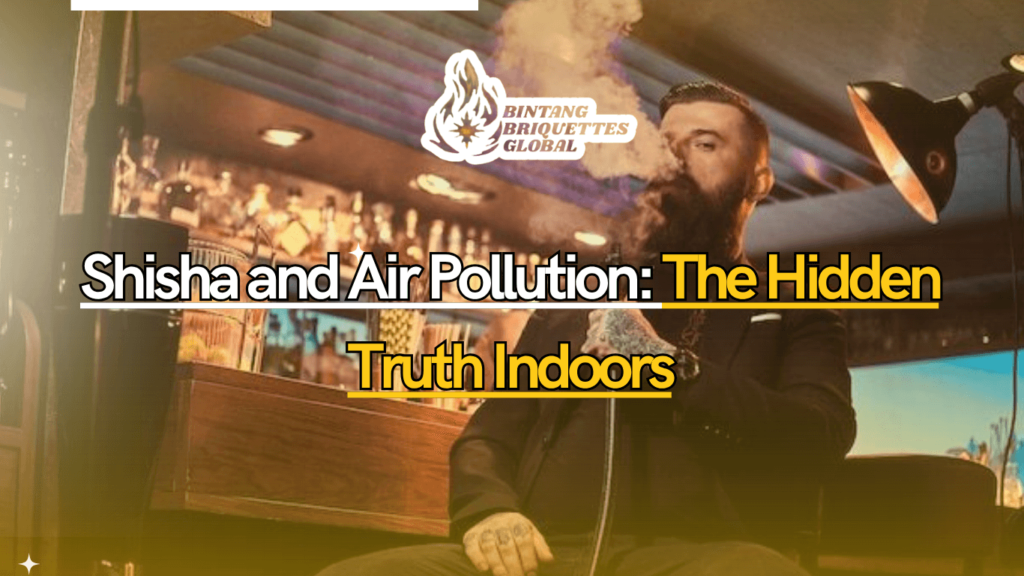Introduction
bintangbriquettes.com – Shisha, also known as hookah, narghile, or waterpipe, has been an integral part of social and cultural life in many regions for centuries. Sharing shisha with friends or family creates moments of relaxation and bonding. However, behind the alluring aroma and flavorful smoke lies a significant risk—indoor air pollution caused by shisha smoking. Many believe that smoking shisha indoors is less harmful than cigarettes, but the truth is that shisha smoke contaminates indoor air to a dangerous extent, posing serious health risks.
This article aims to uncover the hidden truth about indoor air pollution from shisha, explaining how it contaminates the air, the health hazards involved, and practical solutions to reduce its harmful impact.
1. What is Shisha?
Shisha is a method of smoking flavored tobacco heated by charcoal, with smoke filtered through water before inhalation. This process produces a smoother and cooler smoke than regular cigarettes. Shisha smoking is usually a social activity, with several people sharing the same device.
1.1 Main Components of Shisha
- Bowl: Holds the moist flavored tobacco (ma’assel)
- Charcoal: Provides heat to vaporize the tobacco
- Water Chamber: Filters and cools the smoke
- Hose: Delivers smoke to the user
Though simple in design, the interaction of charcoal, tobacco, and water produces complex smoke laden with harmful chemicals.
2. Indoor Air Pollution: A Hidden Danger
Indoor air pollution refers to the presence of harmful contaminants in the air within enclosed spaces. Exposure to indoor pollution can lead to both immediate and long-term health problems.
2.1 Sources of Pollution in Shisha
- Tobacco Smoke: Contains nicotine, tar, and carcinogens
- Charcoal Emissions: Release carbon monoxide (CO), volatile organic compounds (VOCs), and fine particles
- Secondhand Smoke: Smoke released into the air when not inhaled by the smoker
3. How Shisha Pollutes Indoor Air
3.1 Composition of Shisha Smoke
Shisha smoke contains not only nicotine and tar like cigarettes but also high concentrations of carbon monoxide, heavy metals (such as lead and arsenic), and numerous carcinogenic chemicals. Sessions often last an hour or more, generating large volumes of smoke and allowing toxic pollutants to accumulate indoors.
3.2 Charcoal Emissions
Charcoal used for heating tobacco is a major source of indoor air pollutants. Quick-light charcoal, widely used for convenience, contains chemical additives that release more toxic gases. Even natural charcoal, such as coconut shell charcoal, emits carbon monoxide and VOCs, though to a lesser degree.
3.3 Fine Particulate Matter (PM2.5)
Fine particles smaller than 2.5 micrometers can penetrate deep into the lungs and bloodstream. Repeated exposure to PM2.5 is linked to respiratory diseases, heart attacks, and cardiovascular problems.
4. Health Risks of Indoor Shisha Smoke Exposure
4.1 Effects on Shisha Smokers
- Respiratory Problems: Bronchitis, worsening asthma, reduced lung function
- Heart Disease: Carbon monoxide reduces oxygen transport in the blood
- Cancer Risk: Increased exposure to carcinogens significantly raises cancer risk
4.2 Impact on Non-Smokers (Secondhand Smoke)
People sharing the same indoor space as shisha smokers can suffer similar health issues due to secondhand smoke exposure—this includes children, pregnant women, and the elderly.
4.3 Vulnerable Groups
Children and individuals with chronic respiratory conditions are especially susceptible to harm from indoor shisha smoke, facing higher risks of respiratory infections and impaired lung development.
5. Ventilation and Indoor Air Quality
5.1 Importance of Ventilation
Proper ventilation dilutes indoor pollutants by replacing contaminated air with fresh air, reducing the concentration of harmful substances.
5.2 Lack of Ventilation in Shisha Venues
Many shisha lounges and homes lack adequate ventilation systems, allowing toxic smoke to accumulate and increasing exposure risks.
6. How to Reduce Indoor Air Pollution from Shisha
6.1 Use Natural Charcoal
Natural charcoals, such as coconut shell charcoal, produce less carbon monoxide and VOCs compared to quick-light charcoal, thus better for indoor air quality.
6.2 Designate Smoke-Free Zones
Separating smoking and non-smoking areas helps protect non-smokers from exposure.
6.3 Use HEPA Air Purifiers
Air purifiers with HEPA filters can reduce fine particulate matter in indoor air, though they cannot remove all chemical pollutants completely.
6.4 Raise Awareness and Educate
Educating shisha users and venues about the health risks and importance of ventilation encourages safer practices.
7. Social and Cultural Perspectives
Shisha is more than just smoking—it is a cultural and social experience. While health risks are real, harm reduction approaches such as cleaner fuels and improved ventilation can help preserve cultural traditions without compromising health.
8. Current Scientific Research
Recent studies reveal that indoor pollution levels from shisha can exceed WHO guidelines for indoor air quality. Research comparing carbon monoxide emissions from shisha and cigarettes shows shisha emits significantly more CO per smoking session.
9. Conclusion
Shisha may be a beloved cultural pastime, but the indoor air pollution it generates poses serious health risks to smokers and bystanders alike. Toxic smoke and gases emitted during shisha sessions can degrade indoor air quality dramatically. By using cleaner charcoal, improving ventilation, and promoting awareness, it is possible to enjoy shisha with reduced harm. Protecting indoor air quality is essential for the well-being of all occupants.

